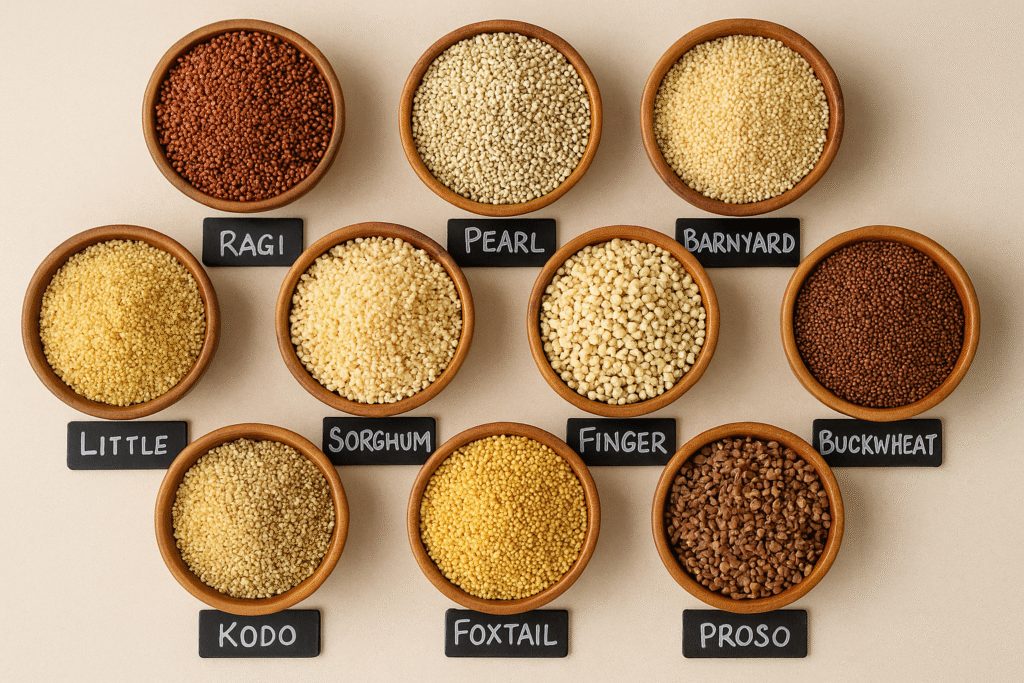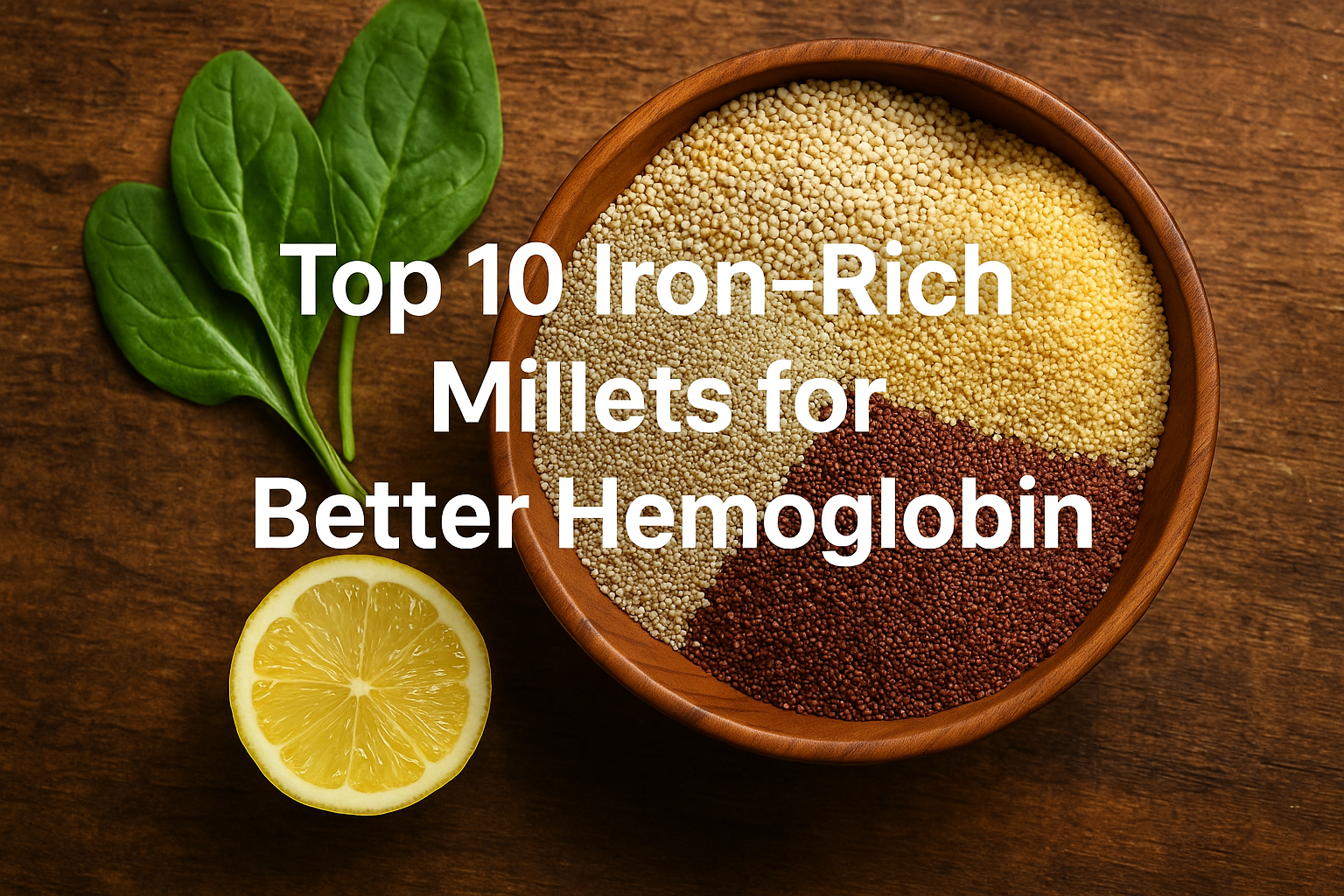If you’re looking to boost your haemoglobin naturally and want to know about Top 10 Iron-Rich Millets, you’re in the right place. These little grains might look plain but they pack a punch when it comes to iron-rich foods, millet benefits, and helping with anaemia. There’s no magic pill here—just wholesome food choices. Let’s chat about how these millets work, why they matter, and how you can use them in everyday meals.
Why these millets matter for iron & hemoglobin
Millets are part of a group of tiny-seed grains grown in India and plenty of other parts of the world. They’re a good source of nutrients and some varieties stand out for iron content. For example: research shows that meals made with millets resulted in a 13.2% increase in haemoglobin levels in study participants.
Regular wheat or rice based diets often don’t give enough iron or have less bio-available iron. But certain millets can offer more, especially when processed (soaked, germinated, fermented) to reduce anti-nutrients.
A quick look: how millets compare
Before diving into each of the 10, here’s a general table summarising what research says about iron in millets:
- Some millets show iron content above 6 mg per 100 g, which is considered “high” for grains.
- Example: one table lists Pearl Millet with 16.9 mg iron/100g, and Barnyard Millet with 15.2 mg/100g.
- Processing (fermentation, germination) improves bioavailable iron (what body can actually use) though raw iron numbers are useful.
So these grains are worthy of attention if you want better haemoglobin, more iron in diet, and less reliance on supplements alone.
The “Top 10 Iron-Rich Millets” you should know
Here are ten millets (some very well-known in India, some less so) which are good for iron. I’ll give you the overview and then some ideas on how to use each one.

1. Pearl Millet (Bajra)
Iron strength: ~ 16.9 mg per 100 g in one data set.
Why pick it: Widely grown in India, affordable, easy to find. Good for iron, fibre, other nutrients.
How to use:
- Make bajra roti or flatbread.
- Cook as a porridge with milk for breakfast.
- Use in khichdi mixed with vegetables for a hearty iron-rich meal.
Pro tip: Soak the grains overnight or use flour made from soaked grains to reduce anti-nutrients.
2. Finger Millet (Ragi)
Iron strength: Varies, some studies show 3.6-7.3 mg/100g or higher for specific cultivars.
Why pick it: Besides iron, very high in calcium. Great as a staple for children and women.
How to use:
- Ragi porridge (especially good for kids or if you feel low on energy).
- Ragi dosa or idli.
- Ragi laddoo or snack mixes (for an iron-boost treat!).
Pro tip: Combine with a vitamin-C rich fruit/juice (say orange or guava) to improve iron absorption.
3. Teff (though not always thought of in everyday Indian kitchens, still a millet)
Iron strength: One study lists ~11.09 mg/100g for some genotypes.
Why pick it: Rare in India but finding popularity; great nutrient profile.
How to use:
- Use teff flour for pancakes or small rotis mixed with other flours.
- Cook teff grain like porridge, top with nuts/fruit.
Pro tip: Since it is less common, start with small amounts and mix with other grains.
4. Barnyard Millet
Iron strength: ~15.2 mg/100 g reported.
Why pick it: Good iron amount; often overlooked; gluten-free; fits into Indian cuisines.
How to use:
- Barnyard millet upma (a tasty breakfast/quick meal).
- Replace rice with barnyard millet when making fried rice or pulao.
Pro tip: Rinse well and soak 15-20 mins before cooking to reduce grit.
5. Little Millet
Iron strength: ~9.3 mg/100 g in some data.
Why pick it: Smaller seed size but good mineral profile; lighter taste; quick to cook.
How to use:
- Little millet khichdi with beans/green peas.
- Use little millet flour for pancakes or snack bars.
Pro tip: Carry some cooked little millet in lunch box—it holds up well.
6. Foxtail Millet
Iron strength: One source gives ~2.8 mg/100 g (lower compared to above) but still supports nutrient variety.
Why pick it: Not the highest iron among these, but offers good other nutrients (protein, fibre) and helps diversify grain intake.
How to use:
- Foxtail millet biryani with veggies and light spices.
- Make foxtail millet salad (cool, fresh, good iron + fibre).
Pro tip: Because iron is moderate, pair with iron-rich veggies or pulses to bolster the effect.
7. Sorghum (Jowar)
Iron strength: The Indian Institute of Millets Research lists ~2.6 mg/100 g for iron in sorghum.
Why pick it: Even though iron is modest, sorghum is often used widely, and replacing some wheat/rice with sorghum helps.
How to use:
- Jowar roti/flatbread with a spinach/paneer side.
- Use sorghum flour in baking (for brownies or muffins) to get whole-grain benefit.
Pro tip: Ensure you cook fully and chew well—whole grains often need more chewing to release nutrients.
8. Kodo Millet
Iron strength: Some data list ~0.5 mg/100g (very low), though I’ll still include it under millets for variety.
Why pick it: Even if iron is low, it’s still healthy, so using a mix of millets is good. But for iron boosting, rely more on the richer ones.
How to use:
- Mixed millet porridge including kodo + little + barnyard.
- Kodo millet dosa or idli when you want something different.
Pro tip: Use kodo as supporting grain, not main source for iron.
9. Proso Millet
Iron strength: ~0.8 mg/100 g in one table.
Why pick it: Again, modest iron. But good to rotate millets in diet rather than stay stuck to one.
How to use:
- Proso millet porridge or pilaf.
- Use proso millet flakes for breakfast cereals.
Pro tip: Since iron is low, combine with legumes or meat (if you eat non-veg) to add iron from other sources.
10. Brown Top Millet (and others)
Iron strength: ~0.65 mg/100 g for one specific type.
Why pick it: Mostly included for completeness of millet types; doesn’t offer high iron but adds diversity.
How to use:
- Mixed millet khichdi/porridge covering many millets together.
- Create “millet mix flour” at home using multiple millets for breads.
Pro tip: Focus on taste, texture, variety; the high-iron ones will carry the load for haemoglobin support.
How to maximise iron uptake from millets?
Even if a millet has high iron, your body may not absorb it fully unless you pay attention to how it’s prepared and what gets paired with it. Simple habits make a difference.
Pair with vitamin C rich foods
Foods high in vitamin C help your body absorb non-heme iron (the plant iron form) better. So when you’re having millet, include:
- a glass of orange juice
- chopped mango or papaya on the side
- bell peppers, broccoli or tomato salad
Avoid iron blockers around the meal
Certain things reduce iron absorption: tea/coffee right after meals, calcium-rich dairy in large amounts, high-phytate foods unprocessed. To get best out of your millet iron:
- Have tea/coffee at least 1-2 hours away from millet meals
- Rinse and soak millets, or germinate/ferment them lightly where possible — this reduces phytates. Studies show processing raised bioavailable iron 2-3x. PMC
- Balance dairy: it’s fine, just separate big servings of milk/yogurt from your millet-meal if you are relying for iron.
Use a mixture of millets + pulses/vegetables
A meal of just the millet might help, but mixing in lentils, beans, green leafy vegetables ups the game.
- Example: Pearl millet + moong dal + spinach
- Barnyard millet + chickpeas + capsicum
This makes sure you’re getting iron, protein and other nutrients working together.
Frequency matters
Eating a high iron millet once a week is good, but for changes in haemoglobin you need consistency. Research mentioned meals over weeks/months improved haemoglobin.
So try to rotate high-iron millets into your diet 3-4 times a week.
Sample daily meal plan using high-iron millets
Here’s how you can slot these millets into a day so you don’t feel bored and still target iron improvement.
| Meal | Millet & dish idea | What else to add |
| Breakfast | Pearl millet porridge with milk/honey | Add a small orange or kiwi (vitamin C) |
| Mid-morning snack | Finger millet (ragi) muffins made with banana | Few almonds |
| Lunch | Barnyard millet upma + mixed vegetable salad (capsicum, tomato) | Lemon dressing to add C |
| Evening snack | Little millet snack bars with dried fruit | Green tea 30 mins after snack |
| Dinner | Barnyard or pearl millet roti + spinach/chickpea curry | Steamed broccoli side |
You could swap millets — perhaps dinner is finger millet dosa tomorrow, lunch is teff pilaf. The key is mixing and eating regularly.
Local availability in India / meal prepping tips
- Many Indian stores sell bajra, ragi, barnyard millet, little millet etc.
- Flour: you can buy ready flour of these millets or make your own by cleaning, drying and grinding.
- Cook in batch: For example, cook barnyard millet in bulk and freeze portions (just like rice) for quick weekday lunches.
- Mix with regular grains: Not necessary to completely replace rice/wheat — even partial replacement helps.
Mistakes to avoid
- Relying only on a single millet type and ignoring others.
- Not pairing with vitamin C → kick-start absorption.
- Over-cooking and losing texture/flavour (makes it less appealing so you stop).
- Eating teas/coffees, or high-calcium meals right around your millet iron-meal.
- Assuming that just because the millet is “iron-rich” you’ll instantly fix haemoglobin — consistency + overall diet matters.
Final thoughts
If you want to improve your haemoglobin naturally, the Top 10 Iron-Rich Millets offer excellent options. They’re friendly on the budget, versatile in kitchen, and do real work. Use them regularly, pair smartly, and treat your body well. With a few small changes and variety—your body will thank you.
Aim to include millets like pearl millet, barnyard millet, little millet, and others in ways you enjoy (yes, tasty is possible!). Regular use of iron-rich millets, the right food pairings, and consistent meals can move the needle on your iron status.
Here’s to better haemoglobin and stronger health—without boring diets. Let your food do the heavy lifting.
Common questions and things to watch
Are millets enough alone for iron deficiency/anaemia?
Good question. Millets help significantly, but if you already have moderate to severe anaemia you should check with a doctor. Millets plus diet change plus possible supplements (as advised) is usually the path. Studies showed millets improved haemoglobin more than regular grains.
Will all the iron in millets get absorbed?
No. Plant-based iron (non-heme) has lower bioavailability than iron from animal sources. But processing (fermenting, germinating) and pairing with vitamin C foods help raise absorption.
Can I eat millets every day?
Yes, you can, but variety helps avoid taste fatigue and ensures you get other nutrients too. Use high-iron ones more often, others to rotate.
What about millets and other nutrients?
Great you ask. Millets not only offer iron, they also deliver fiber, vitamins, minerals, are often gluten-free. For example, one source says millets provide more essential amino acids than many other cereals.

